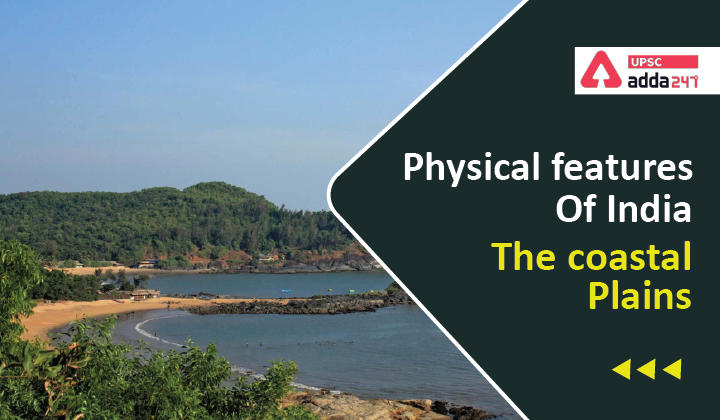Table of Contents
The Coastal Plains of India: Relevance
- GS 1: Distribution of key natural resources across the world
Physical Features of India
- India’s physical features can majorly be divided into 6 parts:
- The Northern and North-eastern Mountains
- The Northern Plain
- The Peninsular Plateau
- The Indian Desert
- The Coastal Plains of India
- The Islands.
- We have already dealt with Himalayas, Northern Plains and Peninsular Plateau comprehensively. In this article, we will discuss about The Coastal Plains of India.
The Coastal Plains of India: Coastline of India
- India has a coastline of more than 7500 Km that touches 13 States and Union Territories (UTs).
- The straight and regular coastline of India has resulted from faulting of the Gondwanaland during the Cretaceous period.
- On the basis of the location and active geomorphological processes, it can be broadly divided into two:
- the western coastal plains,
- the eastern coastal plains.
Eastern Coastal Plains of India
- East coast of India lies between the Eastern Ghats and the Bay of Bengal.
- East coast extends from Ganga delta to Kanyakumari.
- East coast has well developed deltas, formed by the rivers like Mahanadi, Godavari, Krishna and Kaveri flowing eastward in to the Bay of Bengal.
- Regional names: Utkal coast in Odisha; Coramandal Coast or Payan Ghat in Andhra Pradesh and Tamil Nadu.
Coastline of emergence
- Coastline of emergence is formed either due to an uplift of the land or due to the lowering of the sea level. Coastline of submergence is the opposite of coastline of submergence.
- Because of the emergent nature of east coast, it has less number of ports and harbours.
- The continental shelf extends up to 500 km into the sea, which makes it difficult for the development of good ports and harbours.
Western Coastal Plains of India
- The west coast of India extends from the Gulf of Cambay (Gulf of Khambhat) in Gujarat to Cape Comorin in Kanyakumari.
- The western coast may be divided into following divisions – the Kachchh and Kathiawar coast in Gujarat, Konkan coast in Maharashtra, Goan coast and Malabar coast in Karnataka and Kerala respectively.
- The rivers flowing through this coastal plain do not form deltas, but form coves, creeks and a few estuaries.
- Delta: Deltas are wetlands that form as rivers empty their water and sediment into another body of water, such as an ocean, lake, or another river.
- Coves: A cove is a type of small, sheltered bay on the coast of an ocean, lake, or river.
- Creeks: a narrow area of water that flows into the land from the sea, a lake, etc.
- Estuary: Estuaries and their surrounding wetlands are bodies of water usually found where rivers meet the sea.
- The Malabar coast has got certain distinguishing features in the form of ‘Kayals’ (backwaters), which are used for fishing, inland navigation and also due to its special attraction for tourists.
Coastline of submergence
- The western coastal plains are an example of submerged coastal plain. Because of this submergence, it is a narrow belt and provides natural conditions for the development of ports and harbours. Kandla, Mazagaon, JLN port Navha Sheva, Marmagao, Mangalore, Cochin, etc. are some of the important natural ports located along the west coast.
- It is believed that the city of Dwarka which was once a part of the Indian mainland situated along the west coast is submerged under water.
Also Read:
| Horticulture In India: Horticulture Cluster Development Programme | Migrant Labour Crisis: Supreme Court Guidelines, Issues And Solutions | Legislative Council: A Complete Analysis | Unlawful Activities (Prevention) Act (UAPA), 1967 |
| Financial Stability Report | Freight Smart Cities: Logistics Issues and Government Steps | Fishery Subsidy And The Issues Arising From It | Understanding the India- Afghanistan Conundrum |
| The History of Backward Classes Commission And the Sub-Categorisation of OBCs | Elderly Population Of India: Expert Committee On Longevity Finance | Impact of US Inflation in India | Pradhan Mantri Awas Yojana- Gramin |



 TSPSC Group 1 Question Paper 2024, Downl...
TSPSC Group 1 Question Paper 2024, Downl...
 TSPSC Group 1 Answer key 2024 Out, Downl...
TSPSC Group 1 Answer key 2024 Out, Downl...
 UPSC Prelims 2024 Question Paper, Downlo...
UPSC Prelims 2024 Question Paper, Downlo...




